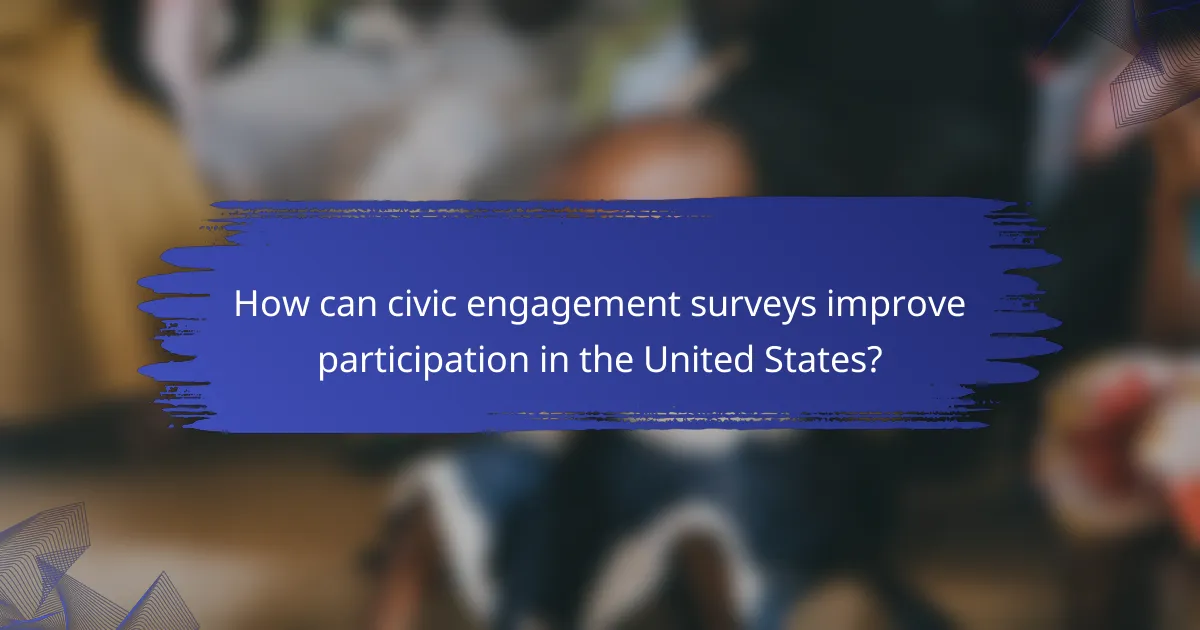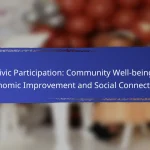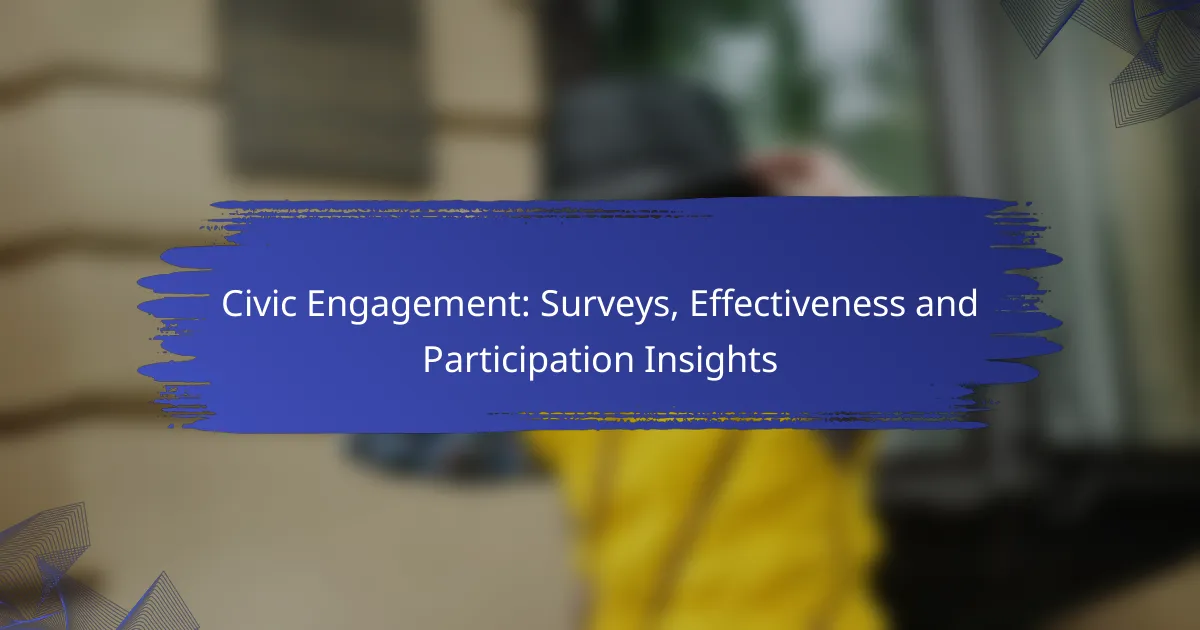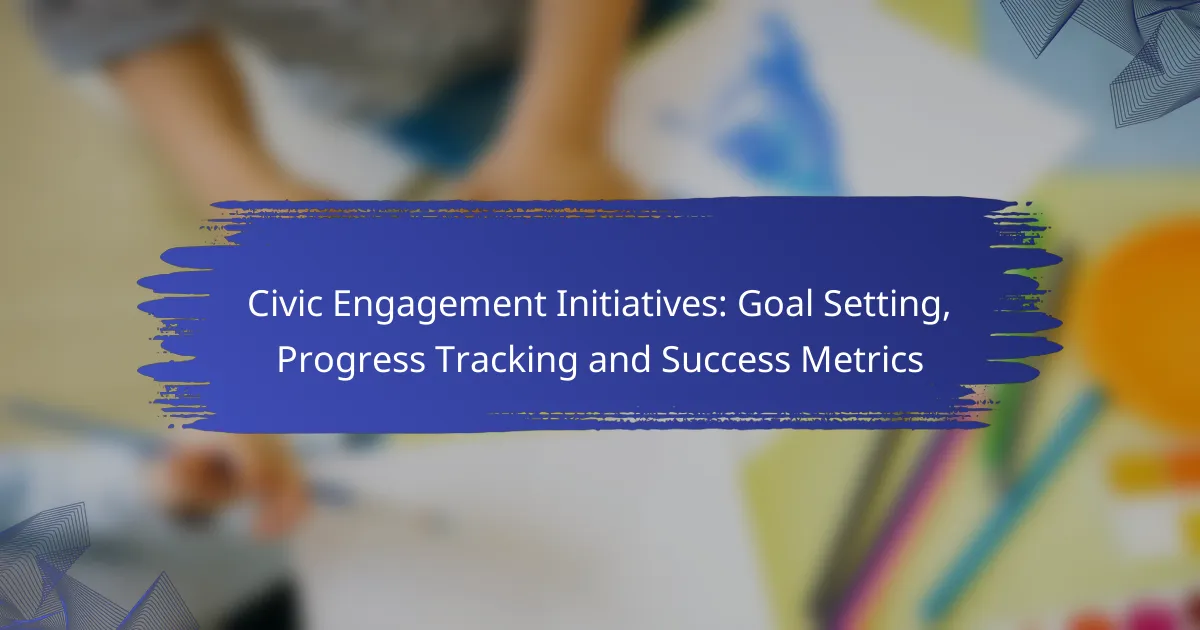Civic engagement surveys play a crucial role in enhancing participation by capturing valuable insights from communities across the United States. By identifying barriers and areas for improvement, these surveys help foster a more engaged citizenry. Effective strategies, such as workshops and social media campaigns, further strengthen community ties and encourage diverse participation influenced by demographics like age and education.

How can civic engagement surveys improve participation in the United States?
Civic engagement surveys can significantly enhance participation in the United States by gathering insights directly from the community. These surveys identify barriers to participation and highlight areas for improvement, ultimately fostering a more engaged citizenry.
Enhanced feedback mechanisms
Enhanced feedback mechanisms allow communities to voice their opinions and concerns effectively. By utilizing surveys, local governments can collect valuable input from residents, ensuring that their needs and preferences are considered in decision-making processes.
For instance, a city may conduct a survey to assess public interest in new park developments. The feedback can guide planners in creating spaces that truly reflect community desires, leading to higher participation in local initiatives.
Data-driven decision making
Data-driven decision making involves using survey results to inform policies and programs. By analyzing feedback, civic leaders can prioritize initiatives that resonate with the community, making it more likely that residents will engage with these efforts.
For example, if a survey reveals that residents are concerned about public safety, local authorities can allocate resources to address these issues, ultimately increasing community involvement in safety programs and initiatives.
Increased community trust
Increased community trust stems from transparency and responsiveness to citizen feedback. When residents see their input valued and acted upon, they are more likely to participate in future civic activities.
Regularly conducting surveys and sharing results fosters a culture of openness, encouraging citizens to engage with local governance and initiatives, knowing their voices matter.
Targeted outreach strategies
Targeted outreach strategies utilize survey data to identify specific demographics or groups that may need additional encouragement to participate. By understanding the barriers faced by these groups, organizations can tailor their outreach efforts accordingly.
For instance, if surveys indicate low participation among young adults, local governments can develop programs or events specifically designed to attract this demographic, such as social media campaigns or community events that cater to their interests.
Real-time engagement tracking
Real-time engagement tracking allows organizations to monitor participation levels and adjust strategies as needed. By implementing surveys at various stages of civic initiatives, leaders can gauge community interest and adapt their approaches to maintain or boost engagement.
For example, tracking responses during a public meeting series can help organizers understand which topics resonate most, enabling them to focus future discussions on areas of high interest and concern, thus enhancing overall participation.

What are the most effective civic engagement strategies?
Effective civic engagement strategies foster participation and strengthen community ties. Key approaches include community workshops, online platforms, social media campaigns, and public forums, each offering unique benefits and considerations for maximizing involvement.
Community workshops
Community workshops are interactive sessions that encourage residents to discuss local issues and collaborate on solutions. These workshops often involve hands-on activities, allowing participants to express their opinions and brainstorm ideas in a supportive environment.
To maximize effectiveness, workshops should be well-facilitated and inclusive, ensuring diverse voices are heard. Consider scheduling them at convenient times and locations, and provide refreshments to encourage attendance.
Online platforms like Nextdoor
Online platforms such as Nextdoor facilitate neighborhood-level communication and engagement. These platforms allow residents to share information, ask questions, and organize community events, making it easier to connect with local issues and initiatives.
When using online platforms, it’s essential to maintain a respectful tone and encourage constructive dialogue. Regularly posting updates and engaging with community members can enhance participation and foster a sense of belonging.
Social media campaigns
Social media campaigns leverage platforms like Facebook, Twitter, and Instagram to raise awareness and mobilize community members around specific causes. These campaigns can reach a broad audience quickly and effectively, making them a powerful tool for civic engagement.
To create impactful campaigns, use clear messaging, engaging visuals, and relevant hashtags. Encourage sharing and interaction to amplify reach, but be mindful of potential misinformation and strive for accuracy in all communications.
Public forums and town halls
Public forums and town halls provide a venue for residents to engage directly with local officials and discuss pressing issues. These gatherings promote transparency and accountability, allowing community members to voice concerns and ask questions in real-time.
To enhance participation, ensure these events are well-publicized and accessible. Consider offering virtual attendance options and providing materials in multiple languages to accommodate diverse populations.

What role do demographics play in civic engagement?
Demographics significantly influence civic engagement, affecting how different groups participate in community activities, voting, and advocacy. Factors such as age, education, and geographic location shape the levels and types of involvement seen in various populations.
Age-specific participation trends
Age is a crucial factor in civic engagement, with younger individuals often participating less than older generations. For instance, those aged 18-24 typically show lower voting rates compared to those aged 65 and above, who tend to be more active in elections and community initiatives.
Engagement strategies should consider these trends. For younger demographics, social media campaigns and digital platforms can be effective in increasing participation, while older individuals may respond better to traditional outreach methods like community meetings and direct mail.
Impact of education levels
Education level is strongly correlated with civic engagement, as individuals with higher education tend to participate more in civic activities. Those with a college degree are often more informed about political issues and more likely to vote compared to those with only a high school education.
Efforts to boost engagement should focus on educational initiatives that inform citizens about their rights and responsibilities. Community workshops and informational sessions can help bridge the gap for those with lower educational attainment, encouraging greater involvement.
Geographic disparities in engagement
Geographic location plays a significant role in civic engagement, with urban areas generally showing higher participation rates than rural regions. This disparity can be attributed to factors such as access to resources, community networks, and local governance structures.
To address these geographic differences, tailored approaches are necessary. Urban areas may benefit from large-scale events and digital outreach, while rural communities might require localized initiatives that foster personal connections and build trust within smaller populations.

How can organizations measure civic engagement effectiveness?
Organizations can measure civic engagement effectiveness through various methods that assess participation levels and the impact of their initiatives. Key approaches include surveys, participation metrics analysis, and longitudinal studies, each providing unique insights into how well civic engagement efforts resonate with the community.
Surveys and feedback forms
Surveys and feedback forms are essential tools for gathering direct input from participants about their experiences and perceptions of civic engagement activities. These instruments can include multiple-choice questions, open-ended responses, and rating scales to capture a range of sentiments.
To maximize effectiveness, organizations should ensure surveys are concise and targeted, ideally taking no longer than 5-10 minutes to complete. Offering incentives, such as small gift cards or entry into a raffle, can also enhance response rates.
Participation metrics analysis
Participation metrics analysis involves examining quantitative data related to civic engagement activities, such as attendance numbers, volunteer hours, and event participation rates. This analysis helps organizations identify trends and patterns in community involvement.
Key metrics to consider include the percentage of the target population engaged, changes in participation over time, and demographic breakdowns. Organizations should aim to track these metrics consistently to evaluate the effectiveness of their outreach strategies.
Longitudinal studies
Longitudinal studies track civic engagement over extended periods, allowing organizations to observe changes in behavior and attitudes within the community. This method provides a deeper understanding of how engagement initiatives influence civic participation over time.
When conducting longitudinal studies, organizations should establish clear benchmarks and regularly collect data at set intervals. This approach can reveal long-term impacts and help refine future engagement strategies based on observed outcomes.

What are the key components of a successful civic engagement survey?
A successful civic engagement survey includes clear objectives, a well-defined target audience, and effective methods for data collection. These components ensure that the survey yields actionable insights and fosters meaningful participation in civic activities.
Clear objectives and goals
Establishing clear objectives and goals is essential for any civic engagement survey. These objectives should outline what the survey aims to achieve, such as understanding community needs, measuring satisfaction with local services, or gauging interest in specific civic initiatives.
When setting goals, consider using the SMART criteria: Specific, Measurable, Achievable, Relevant, and Time-bound. For example, instead of a vague goal like “improve community engagement,” a SMART goal would be “increase participation in local town hall meetings by 20% within six months.”
Targeted audience identification
Identifying the targeted audience is crucial for the effectiveness of a civic engagement survey. This involves determining who will be surveyed, such as residents of a specific neighborhood, age groups, or demographic segments. Tailoring the survey to the right audience ensures that the feedback is relevant and representative.
To effectively identify your audience, consider conducting preliminary research or using existing demographic data. Engaging with community leaders or organizations can also help in reaching underrepresented groups, ensuring a more comprehensive understanding of civic engagement across different segments of the population.










